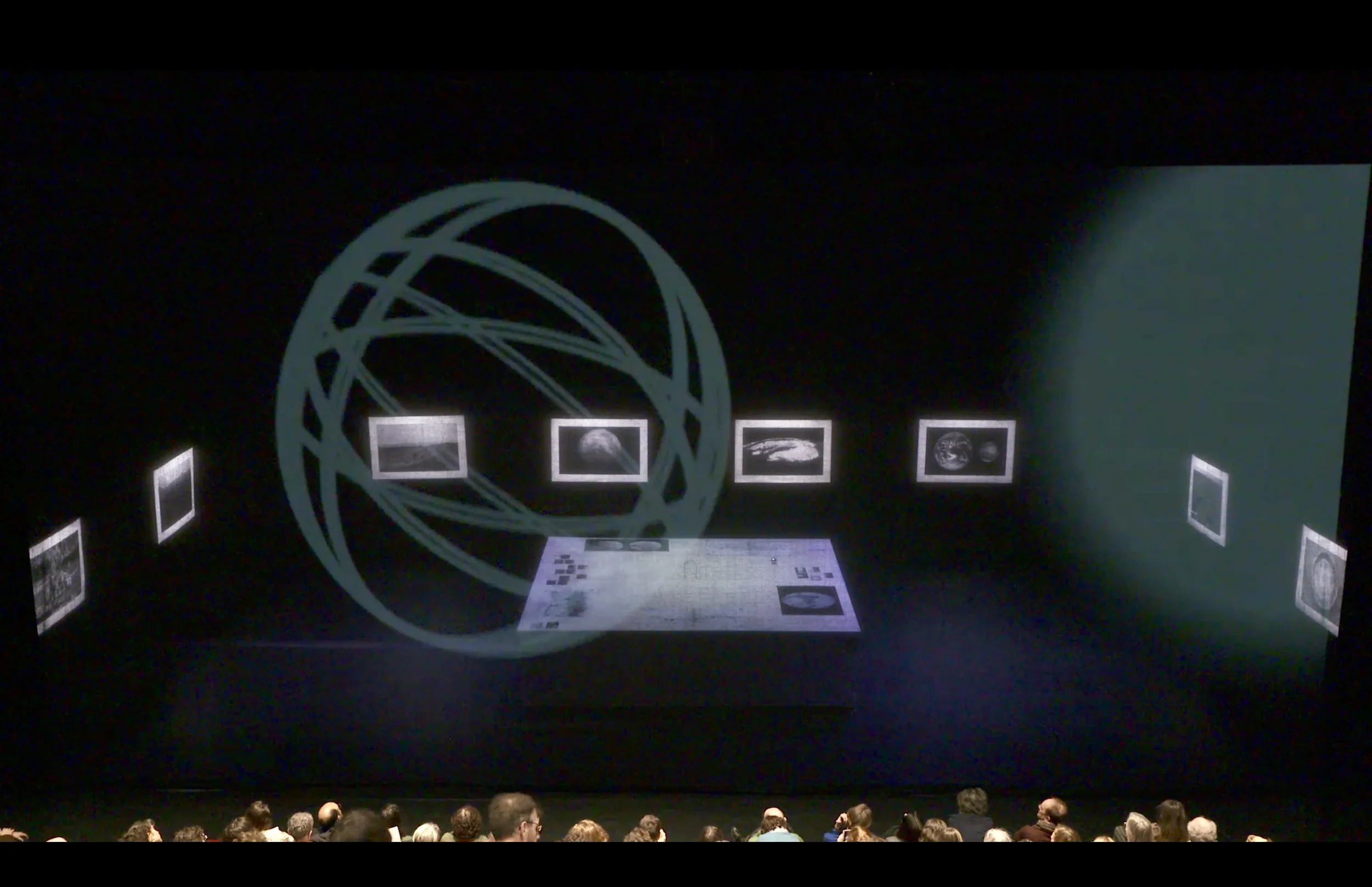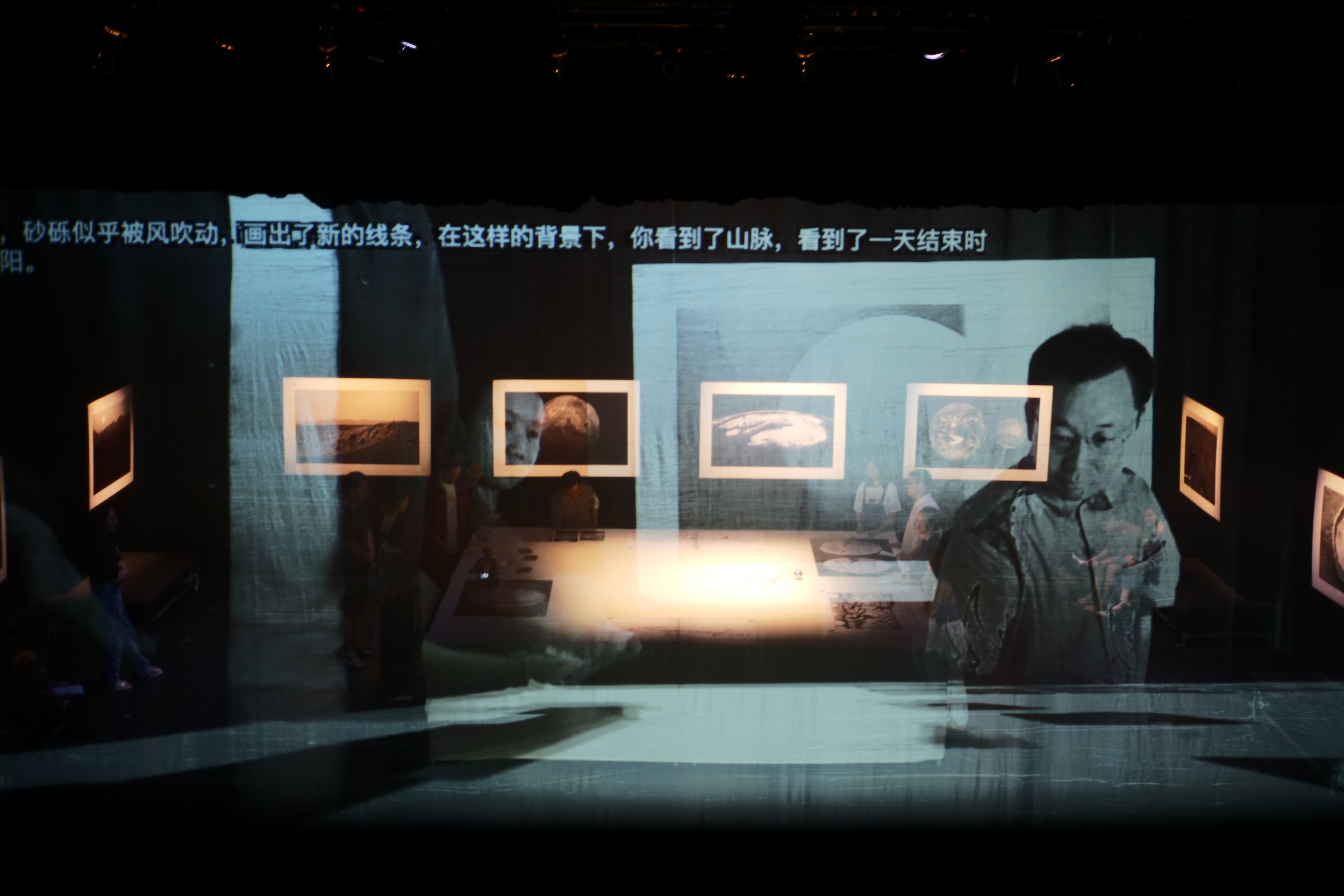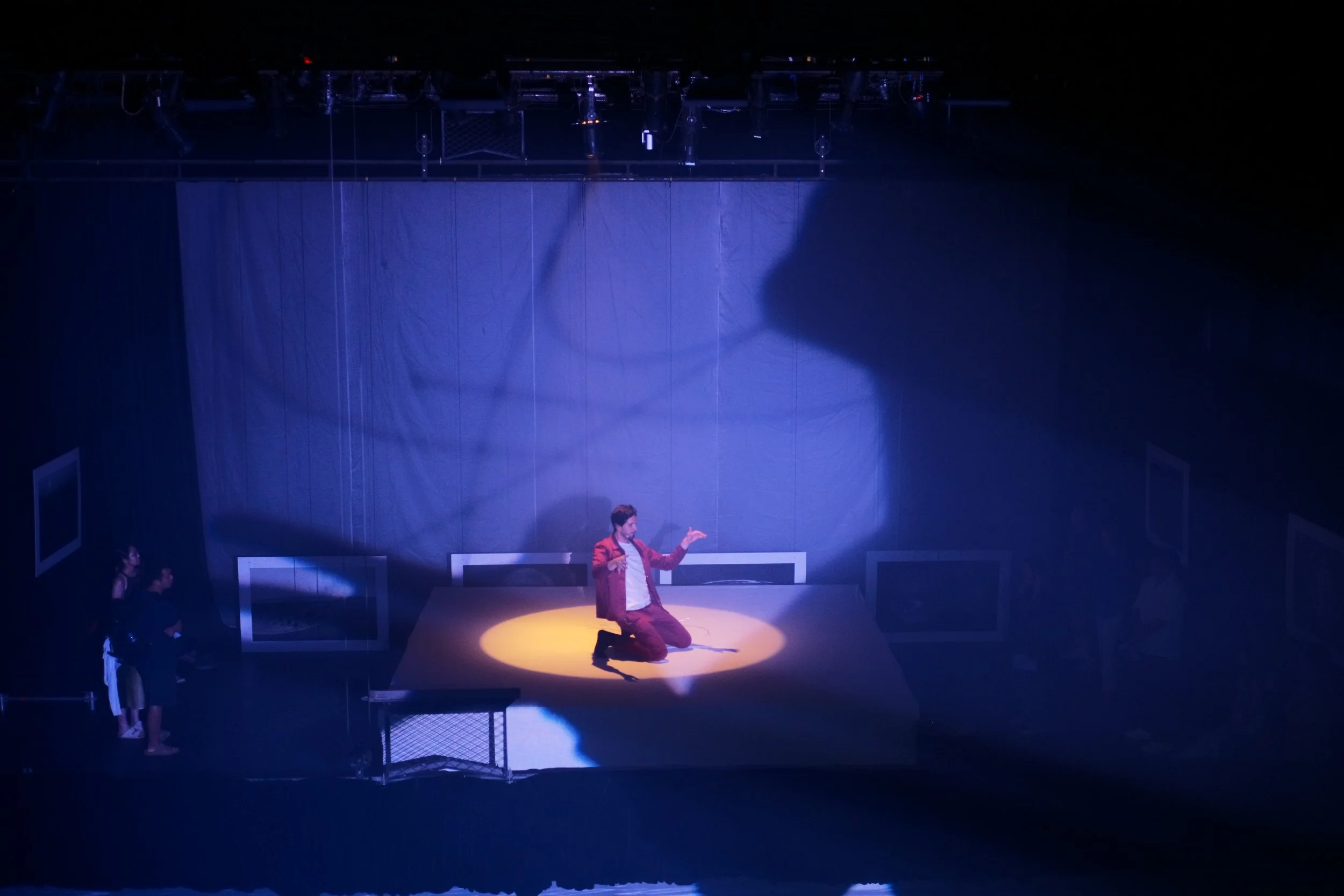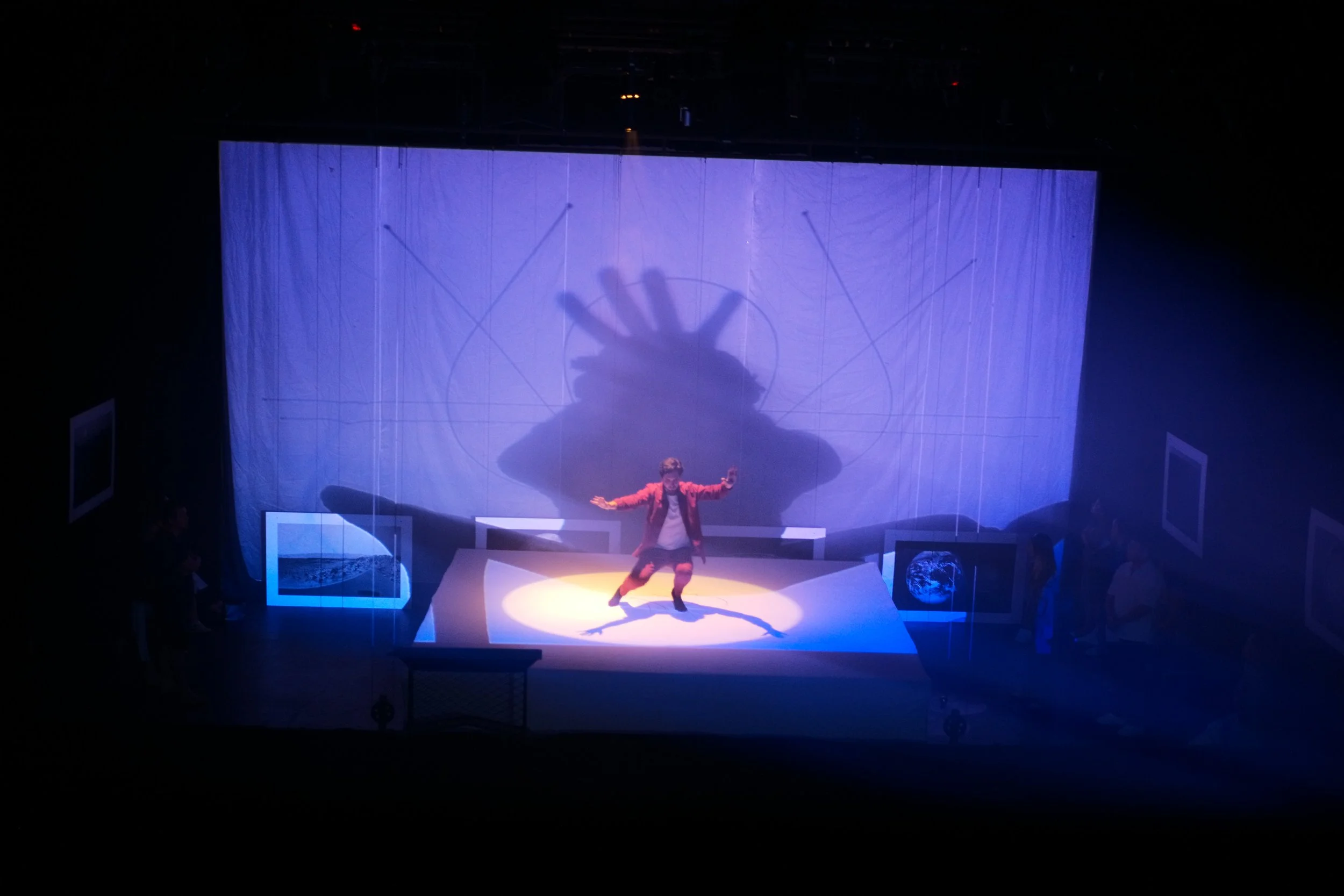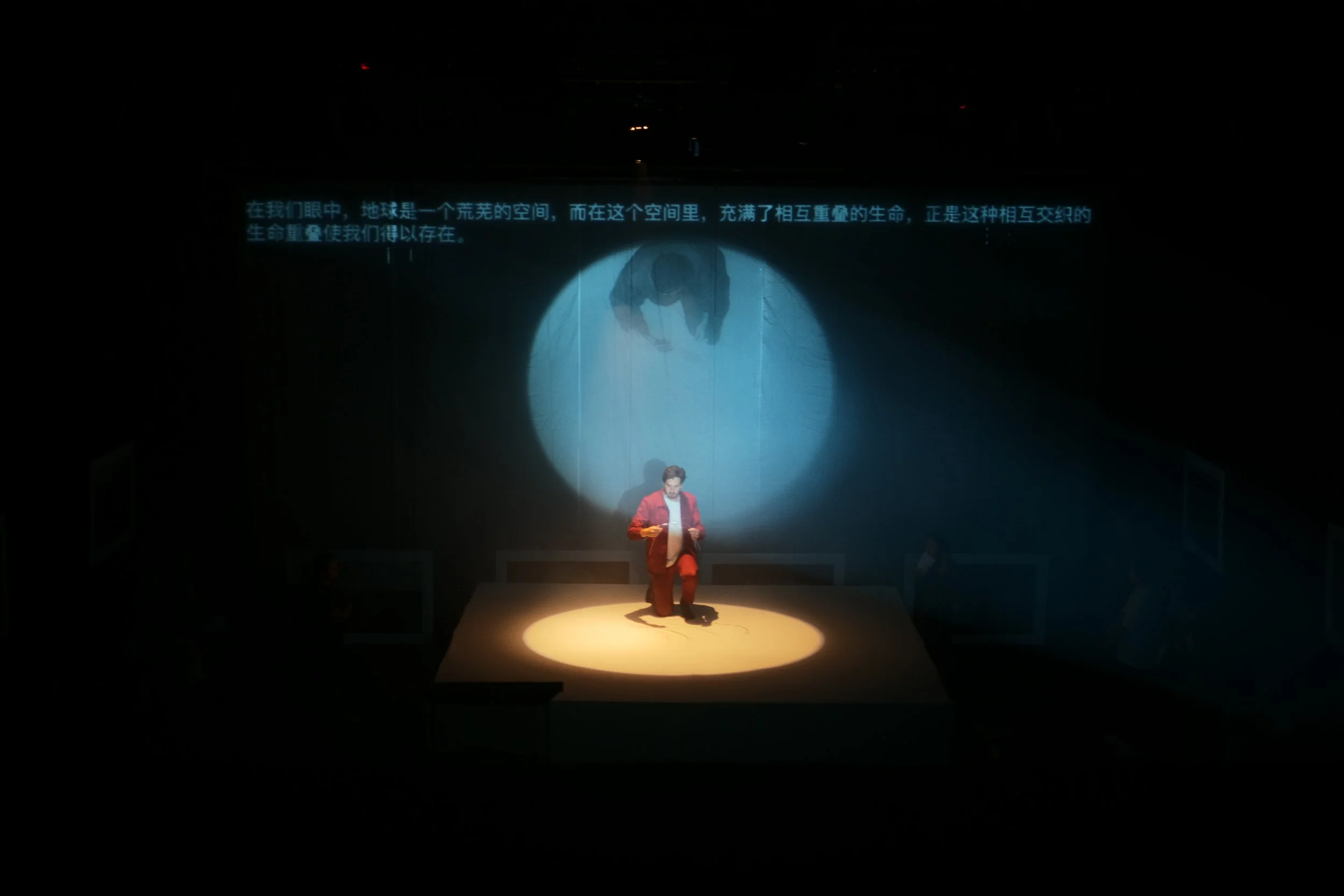Viral
Écrit par Bruno Latour et mis en scène par Frédérique Aït-Touati, VIRAL explore les relations entre les vivants et une planète en transformation. J’ai conçu une scénographie immersive et modulable, centrée sur une table hybride, des projections, et des matériaux réemployés, pour accompagner la déconstruction progressive de l’espace et des représentations. Cette approche soutient une réflexion sur les tensions entre observation scientifique, symbolisme, et interaction avec le spectateur.
Written by Bruno Latour and directed by Frédérique Aït-Touati, VIRAL examines the relationships between living beings and a planet in transformation. I designed an immersive, adaptable scenography centered on a hybrid table, projections, and repurposed materials to support the progressive deconstruction of space and representations. This approach reflects on the tensions between scientific observation, symbolism, and audience interaction.
-
VIRAL, écrit par Bruno Latour et mis en scène par Frédérique Aït-Touati, explore les interrelations entre vivants et leur rapport à une planète en mutation. Mon travail de scénographie s’est attaché à matérialiser ces idées en proposant un dispositif scénique évolutif et immersif, conçu pour accompagner la déconstruction progressive de l’espace et des représentations.
Le point central de la scénographie est une table carrée, recouverte d’un textile réemployé issu des versions unplugged de INSIDE et Moving Earths. Cette table agit comme un espace hybride : à la fois plateforme scénique et table de travail, elle accueille des cartographies de Mars, des objets scientifiques et des masques réalisés par Marie-Sarah Adenis. Ces éléments soulignent l’ambivalence entre la fascination pour Mars, cette planète morte, et le questionnement de nos projections sur cet ailleurs.
La mise en scène débute par une exposition de photographies suspendues, des images retouchées pour évoquer des paysages martiens. Ces clichés, éclairés et intégrés à la scénographie, interrogent la manière dont nous construisons nos représentations scientifiques et esthétiques. Ils introduisent un espace d’observation et de réflexion pour le public, avant que la performance n’entame un basculement.
Un écran de tulle cloisonne d’abord le plateau, créant un espace où les spectateurs présents se déplacent. À mesure que la performance progresse, le tulle tombe, révélant la structure scénique et décomposant les frontières entre espace scénique et espace spectateur. La fumée, montant de sous la table, s’étend progressivement, altérant la perception de l’espace et transformant l’environnement en une scène mouvante, presque insaisissable.
Les projections, quant à elles, sont conçues pour dépasser une fonction illustrative. Elles s’étendent au-delà de la table, jouant sur les échelles pour lier des dimensions biologiques et cosmiques, et pour interroger la tension entre observation scientifique et interprétation symbolique.
Enfin, la création sonore accompagne cette dynamique. En mêlant des captations et des compositions, elle installe une ambiance enveloppante qui soutient les transformations de l’espace et participe à l’expérience immersive du projet.
Cette version de VIRAL a représenté une étape essentielle dans la construction de la Trilogie Terrestre, en explorant de nouvelles façons de repenser les espaces de représentation. Mon approche a consisté à réinterpréter les matériaux disponibles, à concevoir des espaces modulables et à m’adapter aux évolutions du projet, tout en maintenant une réflexion constante sur la manière dont le dispositif scénique peut soutenir le propos de la performance et enrichir la relation entre spectateurs, espace et texte.
-
VIRAL, written by Bruno Latour and directed by Frédérique Aït-Touati, explores the interrelations between living beings and their relationship to a planet in flux. My scenographic work sought to materialize these ideas by creating an evolving, immersive stage design intended to accompany the progressive deconstruction of space and representation.
At the heart of the scenography lies a square table, covered with reused fabric repurposed from the unplugged versions of INSIDE and Moving Earths. This table serves as a hybrid space—both a stage platform and a workspace—featuring maps of Mars, scientific objects, and masks created by Marie-Sarah Adenis. These elements highlight the duality between our fascination with Mars, a dead planet, and the critique of our projections onto such an otherworldly destination.
The performance begins with an exhibition of suspended photographs, retouched to evoke Martian landscapes. These illuminated and scenographically integrated images question how we construct our scientific and aesthetic representations. They establish a space of observation and contemplation for the audience before the performance shifts into another phase.
A tulle screen initially encloses the stage, creating a space where the audience members can move around. As the performance unfolds, the tulle falls, revealing the scenographic structure and breaking down the boundaries between the stage and the spectators. Smoke rising from beneath the table gradually spreads, altering the perception of the space and transforming the environment into a fluid, almost elusive scene.
The projections were designed to go beyond a mere illustrative function. They expand beyond the table, playing with scale to connect biological and cosmic dimensions, while interrogating the tension between scientific observation and symbolic interpretation.
Finally, the sound design accompanies this dynamic evolution. By blending field recordings with compositions, it creates an enveloping atmosphere that supports the transformation of the space and enhances the project’s immersive experience.
This version of VIRAL marked a critical step in the development of the Trilogie Terrestre, exploring new ways to rethink performance spaces. My approach focused on reinterpreting available materials, designing modular spaces, and adapting to the project’s evolution, all while consistently reflecting on how the scenographic setup could support the performance’s narrative and enrich the interplay between the audience, the space, and the text.
-
Titre de l’œuvre : VIRAL
Année : 2022 (Adaptation pour la Trilogie Terrestre)
Texte : Bruno Latour
Mise en scène : Frédérique Aït-Touati
Scénographie, vidéo et lumières : Patrick Laffont de Lojo
Musique originale : Grian Chatten
Masques viraux : Marie-Sarah Adenis
Interprétation : Duncan Evennou
Médium : Performance immersive intégrant projections vidéo, scénographie modulaire et interaction scénique.
Matériaux
• Plateforme scénique carrée : Praticables recouverts de textile réemployé, servant de table de réflexion et de lieu de performance.
• Photographies suspendues : Retouchées pour évoquer des paysages martiens.
• Masques viraux : Conçus par Marie-Sarah Adenis, symbolisant les frontières entre humain et non-humain.
• Cartographies de Mars : Impressions des canaux martiens intégrées à la scénographie.
• Projections vidéo : Dialoguant avec les dimensions scientifiques et symboliques.
• Système sonore immersif : Intégrant compositions originales et captations en direct.
Description
Dans cette adaptation intégrée à la Trilogie Terrestre, VIRAL explore les relations entre les vivants et leur fascination pour Mars, une planète morte qui agit comme un miroir de nos contradictions.
La performance débute par une exposition de photographies suspendues, plongeant le spectateur dans une réflexion visuelle sur les paysages martiens. La plateforme scénique carrée agit comme un espace hybride, à la fois table de réflexion et scène performative. Au fil de la représentation, le tulle cloisonnant l’espace tombe, symbolisant la déconstruction progressive des frontières entre humain, non-humain, et environnement.
Les masques viraux de Marie-Sarah Adenis ajoutent une dimension symbolique et narrative, tandis que les projections vidéo jouent avec les échelles pour enrichir la perception de l’espace. Une fumée s’élève sous la plateforme, transformant progressivement l’ambiance sensorielle du plateau.
Soutenue par une bande sonore immersive signée Grian Chatten, cette adaptation permet une interaction renouvelée avec le public. Une vingtaine de spectateurs sont invités à rejoindre le plateau, devenant acteurs de cette réflexion collective.
Commande et Production
• Commande : Tangram – Scène Nationale d’Évreux-Louviers
• Production : Zone Critique
• Soutiens : Fondation Carasso, DICRéAM
Diffusion
• 30 avril 2022 : Les Anthroposcènes, Le Tangram (Évreux, France)
• 13, 14, 15 octobre 2022 : Scène de recherche, ENS Paris-Saclay (Saclay, France)
• 27, 28 octobre 2022 : Festival Crossing The Lines, FIAF (New York, USA)
• 5, 6, 7 janvier 2023 : MAIF Social Club (Paris, France) - Version Whitebox immersive.
• 13, 14, 15 et 16 avril 2023 : Le Mois de la Terre, Château d’Hardelot (Hardelot, France)
Note
VIRAL s’inscrit comme un point culminant de la Trilogie Terrestre, offrant une expérience immersive qui questionne les projections humaines sur l’ailleurs, tout en intégrant des dispositifs visuels, sonores et scéniques innovants.
-
Title: VIRAL
Year: 2022 (Adaptation for the Terrestrial Trilogy)
Text: Bruno Latour
Direction: Frédérique Aït-Touati
Set Design, Video, and Lighting: Patrick Laffont de Lojo
Original Music: Grian Chatten
Viral Masks: Marie-Sarah Adenis
Performer: Duncan Evennou
Medium: Immersive performance integrating video projections, modular scenography, and stage interaction.
Materials
• Square Scenic Platform: Practicable modules covered with repurposed textile, serving as both a workspace and performance area.
• Hanging Photographs: Digitally retouched to evoke Martian landscapes.
• Viral Masks: Designed by Marie-Sarah Adenis, symbolizing the boundaries between human and non-human.
• Martian Maps: Printed cartographies of Mars’ canals integrated into the scenography.
• Video Projections: Bridging scientific and symbolic dimensions.
• Immersive Sound System: Incorporating original compositions and live soundscapes.
Description
As part of the Terrestrial Trilogy, VIRAL explores humanity’s fascination with Mars, a dead planet that serves as a mirror for our projections and contradictions.
The performance begins with an exhibition of suspended photographs, reflecting on Martian landscapes. The square scenic platform, central to the performance, serves as a hybrid space—part reflective workspace, part performative stage. As the performance progresses, the tulle initially enclosing the space falls, symbolizing the breakdown of boundaries between human, non-human, and planetary systems.
For its whitebox adaptation at the MAIF Social Club (2023), the scenography embraced minimalism, transforming the performance into an immersive experience. The modular setup allowed the audience to move closer to the performers and projections, fostering a deeper engagement. Smoke, rising from beneath the platform, added an atmospheric depth, while video projections expanded spatial perception.
Marie-Sarah Adenis’ viral masks brought a symbolic narrative to life, examining the tensions between human and non-human identities. The immersive sound design by Grian Chatten complemented the visuals, creating a multisensory dialogue between the audience and the themes of the performance.
Commission and Production
• Commission: Tangram – Scène Nationale d’Évreux-Louviers
• Production: Zone Critique
• Support: Fondation Carasso, DICRéAM
Performances
• April 30, 2022: Les Anthroposcènes, Le Tangram (Évreux, France)
• October 13–15, 2022: Scène de Recherche, ENS Paris-Saclay (Saclay, France)
• October 27–28, 2022: Crossing The Line Festival, FIAF (New York, USA)
• January 5–7, 2023: Whitebox Adaptation, MAIF Social Club (Paris, France)
• April 13–16, 2023: Le Mois de la Terre, Château d’Hardelot (Hardelot, France)
Note
The whitebox adaptation of VIRAL at the MAIF Social Club marked a significant evolution of the performance, offering a minimalist yet immersive reinterpretation. By inviting the audience into the performance space, the production fostered a closer interaction between spectators and performers, amplifying the collective and sensory experience at the heart of the work.
